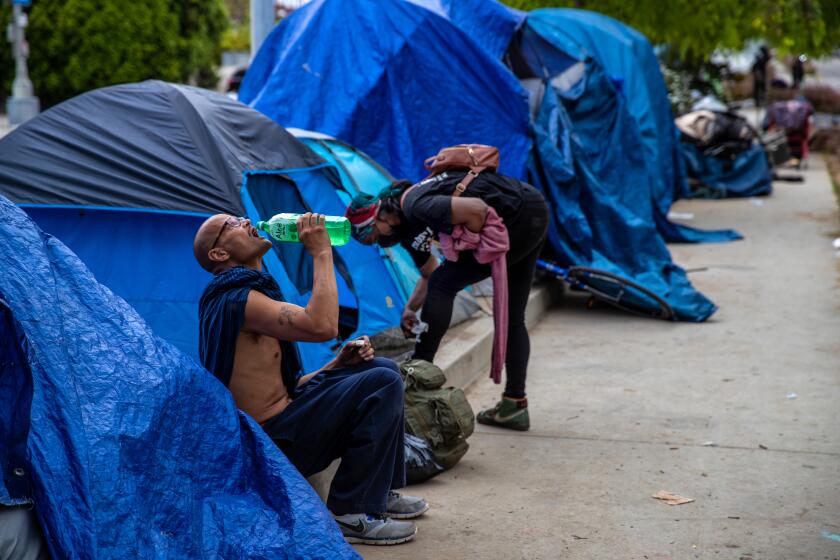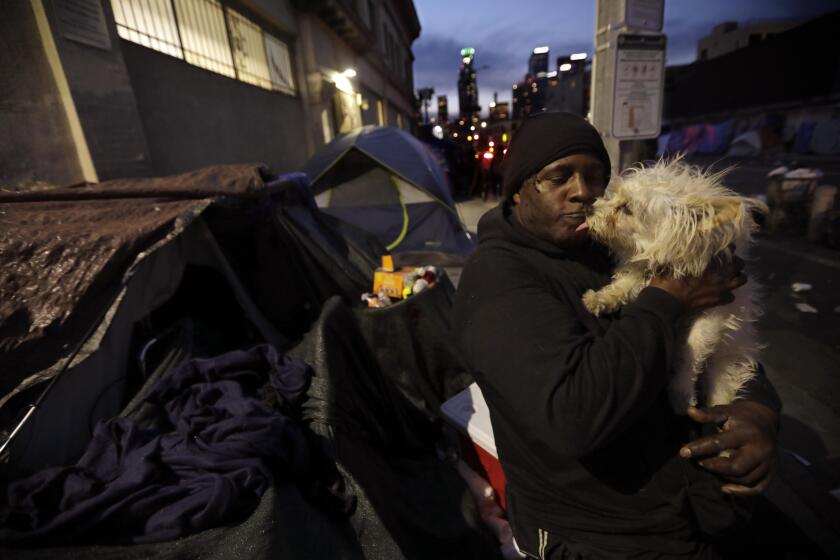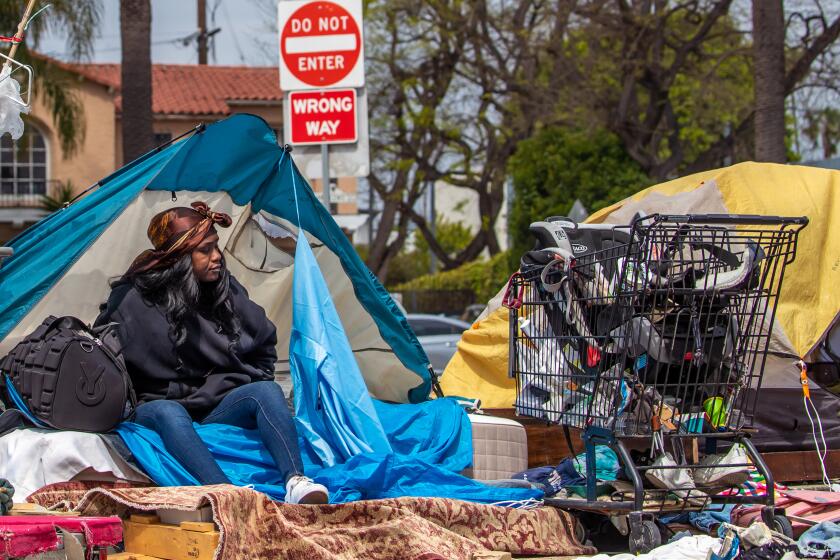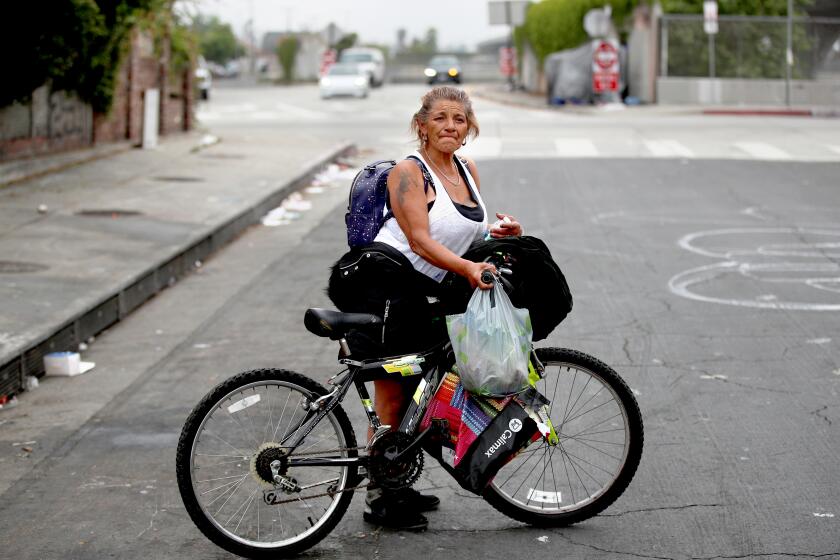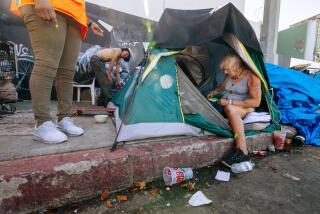Homelessness continues to soar, jumping 9% in L.A. County, 10% in the city

- Share via
Homelessness continues to rise dramatically, increasing by 9% in Los Angeles County and 10% in the city of Los Angeles last year, a stark illustration of the challenges faced by officials trying to reduce the number of people living on the streets.
Efforts to house people, which include hundreds of millions of dollars spent on shelter, permanent housing and outreach, have failed to stem the growth of street encampments, as reflected in the annual point-in-time count released Thursday by the Los Angeles Homeless Services Authority.
The count, conducted by thousands of volunteers during three days in January, projected that 75,518 people were living in interim housing or a tent, car, van, RV, tent or makeshift shelter in Los Angeles County, compared with 69,144 the previous year.
Since the 2015 count, homelessness has increased by 70% in the county and 80% in the city.
L.A. homeless crisis by the numbers: Geographic, demographics and trends
“The results are definitely disappointing with all the hard work and all the investment, but they’re not surprising,” LAHSA’s new chief executive, Va Lecia Adams Kellum, said in a pre-release briefing Tuesday. “We thought with last year’s numbers that we were flattening the curve. However, what we see in this trajectory is that people remain in a situation of vulnerability where they’re falling into homelessness faster than we can house them.
“There’s much more needed to right the ship.”
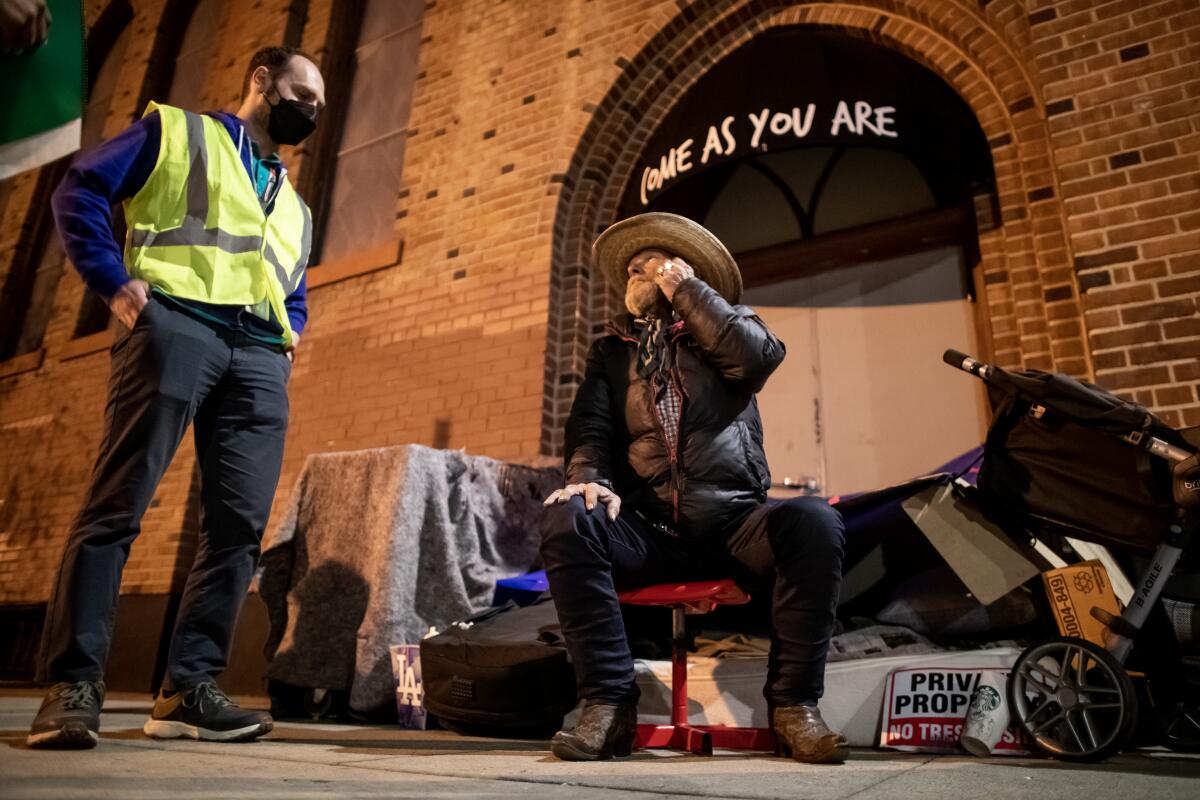
In struggling to explain the continued growth of homelessness, Adams Kellum acknowledged that the reasons are not fully known, but she pointed to economics as the underlying cause. She cited a recent study by UC San Francisco that found that among people who had leases before becoming homeless, a decrease in income was the most common reason for losing their housing.
Almost all the growth came from the Westside and Harbor areas of Los Angeles, with each seeing increases of just over 2,000 people, or about 45%.
South L.A., which has the second-highest number of homeless people in the region behind central Los Angeles, countered the trend with a modest 10% decrease of about 1,600 people. The remainder of the county was statistically unchanged.
What do Angelenos think about the start of Mayor Bass’ tenure? Is the emergency declaration on homelessness working?
The increase was entirely made up of people living on the street, as opposed to those in shelters. Countywide, the unsheltered population jumped 14% to more than 55,000, while the count of people in shelters declined slightly to just over 20,000.
The annual count showed an 18% increase in chronic homelessness, with an even sharper rise among those living outdoors. Just over 27,000 people were living on the street who had been homeless more than a year and had a disabling health, mental health or substance use condition, according to the count — nearly 5,000 more than the year before. Another 5,000 chronically homeless people were counted in shelters, for an increase of 7%.
As in previous years, Black people were over-represented, making up 31% of homeless residents, or more than four times greater than their overall share of the county population. The Latino portion leveled off at nearly 43% after increasing substantially in last year’s count. The count of Asians more than doubled, though at 1,212 it was less than 2% of the whole.
A demographic survey conducted after the count found that 25% of homeless people self-reported experiencing severe mental illness and 30% reported substance use disorder.
Los Angeles Mayor Karen Bass expressed frustration over the latest numbers and concern that the increases would continue as more people fall into homelessness with the end of protections put in place during the pandemic.
“The challenge before us is vast, but we will continue to work with urgency to bring Angelenos inside,” Bass said. “We must sustain our momentum by locking arms with leaders at every level of government as we confront this crisis as the emergency that it is. Lives depend on it.”
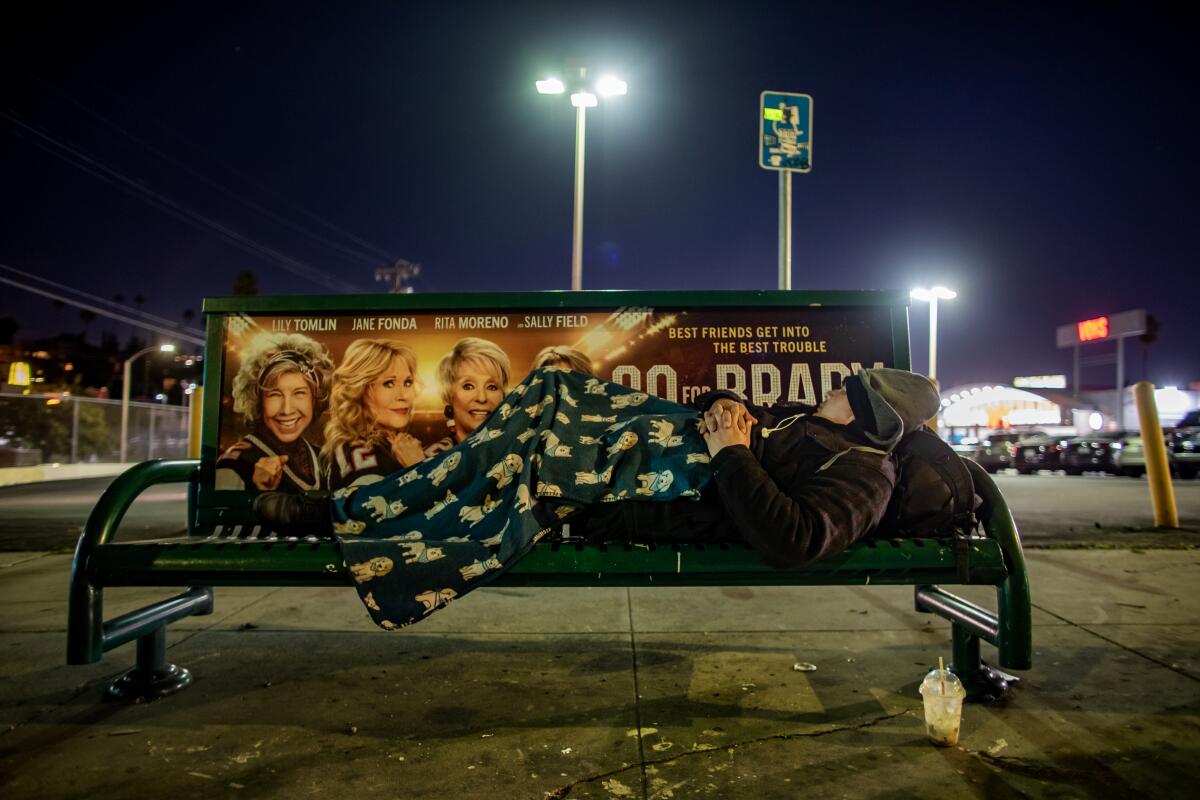
This year’s increase continued an almost unbroken trend that has seen Los Angeles County’s homeless population rise every year except one since 2015, the year before the city and county began pumping funds into homeless housing and services.
Los Angeles city voters adopted Proposition HHH, a $1.2-billion bond measure to build new homeless housing, in 2016. County voters followed the next year with Measure H, a quarter-percent sales tax that generates more than $350 million annually for a variety of initiatives, including shelter beds, housing vouchers and services for permanent housing.
City and county leaders credited those initiatives for a modest 4% decrease in the 2018 count, but that was followed by two years of double-digit increases. After the COVID-19 pandemic forced cancellation of the 2021 count, two more years of increases followed.
During the tenure of Los Angeles Mayor Eric Garcetti, the city’s spending on homelessness grew from a few million to about $1 billion, a large chunk of it HHH funds. In her first budget, Bass allotted $1.3 billion to homeless programs.
Earlier this month, Bass reported that more than 14,000 people experiencing homelessness had been moved off the streets during the first six months of her administration. About 30%, or 4,332, acquired permanent housing, and an additional 10,049 were placed in interim housing through city and county programs from December through May, she said.
About 4,300 unhoused people acquired permanent housing, according to the L.A. mayor’s office. The rest were placed in interim housing.
Bass said the housing placements resulted from executive directives she issued upon taking office, including a state of emergency on homelessness and the launching of the Inside Safe program, which is designed to clear street encampments by moving unhoused people indoors.
Margaret Gillespie, executive vice president of the nonprofit West L.A. Homeless, said she was not surprised to see the number of unhoused people jump on the Westside. She said residents are still recovering from the pandemic.
“I deal with folks pretty regularly, folks who were employed before COVID and lost their jobs and have struggled to get back on their feet,” she said. “People don’t realize that once you fall into the pit of homelessness, it’s very hard to dig out of it.”
Adams Kellum, who was appointed chief executive of the Los Angeles Homeless Services Authority in January, said the city and county are now working with “coordination, collaboration and strategic focus.”
The new strategy has led officials to make some gains in addressing homelessness over the last few months.
For the third consecutive year, Adams Kellum said, the housing system has made more than 20,000 placements. Though little permanent housing was produced during the early years of Proposition HHH, thousands of new units are now being completed, she said.
She also praised Bass’ Inside Safe program as an overwhelming success, noting that emergency directives put into place by the city and county have reduced the time it takes for outreach workers to bring someone into interim housing.
Weeks after the Inside Safe program focused on the streets around El Pueblo, the area still has at least three dozen tents. Other areas face similar issues.
For the first time, LAHSA provided a limited view into the imprecision inherent in its methodology. In the pre-release briefing on Tuesday, a researcher with the agency’s statistical contractor explained how the canvassers’ observations were converted into numbers.
After the street count, researchers survey thousands of homeless people to gather demographic information and calculate averages for the number of people who occupy each type of dwelling, said Benjamin Henwood, a professor at the USC Suzanne Dworak-Peck School of Social Work.
Those averages are then used to estimate the total number of people living on the street. By contrast, the shelter count is a head count gathered directly from the shelters.
While letting its topline numbers for the city and county stand without qualification, LAHSA’s report provided a confidence interval for the total count in its administrative area covering all of L.A. County except Glendale, Long Beach and Pasadena, which conduct their own counts.
With 95% certainty, it said, the number of unsheltered people in that area would be within 1,558 above or below the estimate of 71,320, which doesn’t include the three cities that do their own tallies.
After connectivity breakdowns in a new mobile phone app marred last year’s count and raised doubts about its accuracy, redundancies were introduced this year to ensure that every area was counted, said Paul Rubenstein, LAHSA’s deputy chief of external relations.
More to Read
Sign up for Essential California
The most important California stories and recommendations in your inbox every morning.
You may occasionally receive promotional content from the Los Angeles Times.
